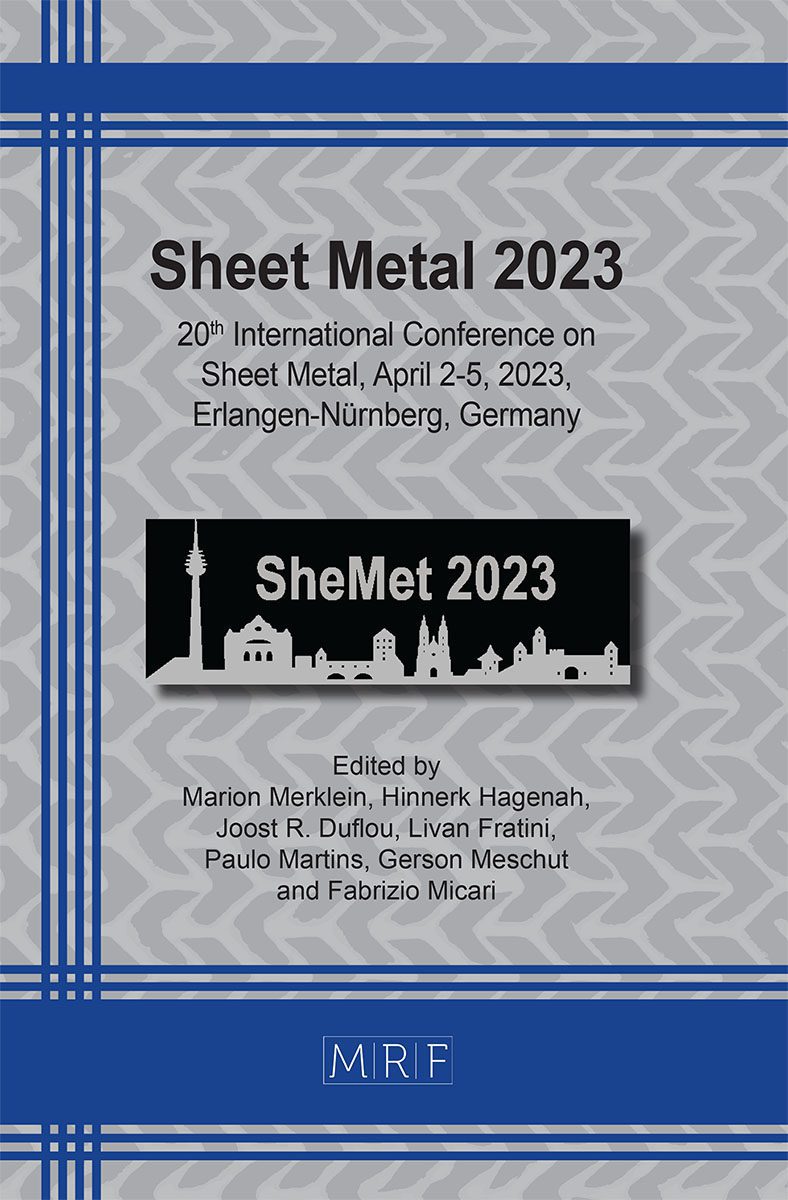Investigation on the shear cutting of functional components manufactured in an orbital forming process
Andreas Hetzel, Michael Lechner, Marion Merklein
download PDFAbstract. Applying forming operations for the manufacturing of complex functional components instead of conventional shearing or milling is an effective way to increase the material efficiency of the process as well as the mechanical properties of the part. Nevertheless, in many cases subsequent cutting operations are mandatory to reach the final geometry or to add functional surfaces for the later assembly. During forming, hardening effects or different strain states can cause difficulties for the subsequent cutting operation. These characteristics are commonly determined for sheet metal forming processes like deep drawing or bending. However, the complex stress and strain states during sheet-bulk metal forming operations and their influence on the cutting parameters or the part properties have not been investigated comprehensively so far. Furthermore, different assigned processes, like for example orbital forming, allow a local material distribution, realizing a gradient in sheet thickness. Therefore, this contribution focuses on the establishment of a fundamental process understanding on the influence of a sheet-bulk metal forming process on the cutting parameters and the resulting part properties. Functional components are manufactured from C10 sheet metal by orbital forming and subsequently shear cut to generate the final contour. During cutting, specific force-stroke diagrams are evaluated, in order to analyze the influence on the process parameters. The resulting properties of the parts are investigated regarding the quality of the cutting surface and a potential geometrical distortion in consequence of elastic spring back. The influence of the forming process is outlined by a direct comparison with conventionally cut components.
Keywords
Metal Forming, Cutting, Orbital Forming
Published online 3/17/2023, 8 pages
Copyright © 2023 by the author(s)
Published under license by Materials Research Forum LLC., Millersville PA, USA
Citation: Andreas Hetzel, Michael Lechner, Marion Merklein, Investigation on the shear cutting of functional components manufactured in an orbital forming process, Materials Research Proceedings, Vol. 25, pp 61-68, 2023
DOI: https://doi.org/10.21741/9781644902417-8
The article was published as article 8 of the book Sheet Metal 2023
![]() Content from this work may be used under the terms of the Creative Commons Attribution 3.0 licence. Any further distribution of this work must maintain attribution to the author(s) and the title of the work, journal citation and DOI.
Content from this work may be used under the terms of the Creative Commons Attribution 3.0 licence. Any further distribution of this work must maintain attribution to the author(s) and the title of the work, journal citation and DOI.
References
[1] H.A. Kishawy, H. Hegab, E. Saad, Design for Sustainable Manufacturing: Approach, Implementation, and Assessment, sustainability. 10,3604 (2018) 1-15. https://doi.org/10.3390/su10103604
[2] R. Neugebauer, W. Drossel, R. Wertheim, et al., Resource and Energy Efficiency in Machining Using High-Performance and Hybrid Processes, Procedia CIRP. 1 (2012) 3-16. https://doi.org/10.1016/j.procir.2012.04.002
[3] M. Merklein, J.M. Allwood, B.-A. Behrens, et al., Bulk forming of sheet metal, CIRP Annals – Manufacturing Technology. 61 (2012) 725-745. https://doi.org/10.1016/j.cirp.2012.05.007
[4] K. Mori, Y. Abe, K. Osakada, et al., Plate forging of tailored blanks having local thickening for deep drawing of square cups, J. Mater. Proc. Technol. 211 (2011) 1569-1574. https://doi.org/10.1016/j.jmatprotec.2011.04.010
[5] M. Merklein, R. Plettke, S. Opel, Orbital forming of tailored blanks from sheet metal, CIRP Annals – Manufacturing Technology. 61 (2012) 263-266. https://doi.org/10.1016/j.cirp.2012.03.130
[6] J. Nowak, L. Madej, S. Ziolkiewicz, et al., Recent development in orbital forging technology, Int. J. Mater. Forming. 1 (2008) 387-390. https://doi.org/10.1007/s12289-008-0076-2
[7] W. Volk, J. Stahl, Shear Cutting, in: L. Laperrière, G. Reinhart (Eds), CIRP Encyclopedia of Production Engineering, Springer, Berlin, Heidelberg, 2015, pp. 1-9. https://doi.org/10.1007/978-3-642-35950-7_16823-1
[8] M. Achouri, G. Germain, P. Dal Santo, et al., Experimental and numerical analysis of micromechanical damage in the punching process for High-Strength Low-Alloy steels, Materials and Design. 56 (2014) 657-670. https://doi.org/10.1016/j.matdes.2013.11.016
[9] A. Totre, R. Nishad, S. Bodke, An Overview Of Factors Affecting In Blanking Processes, Int. J. Emerging Technol. Advanced Engineering. 3-3 (2013) 390-395.
[10] B.S. Levy, C.J. Van Tyne, Review of the Shearing Process for Sheet Steels and Its Effect on Sheared-Edge Stretching, J. Mater. Engineering Performance. 21-7 (2012) 1205-1213. https://doi.org/10.1007/s11665-011-9997-x
[11] K. Mori, Review of Shearing Processes of High Strength Steel Sheets, J. Manuf. Mater. Process. 4-54 (2020) 1-14. https://doi.org/10.1016/j.jmapro.2020.02.041































